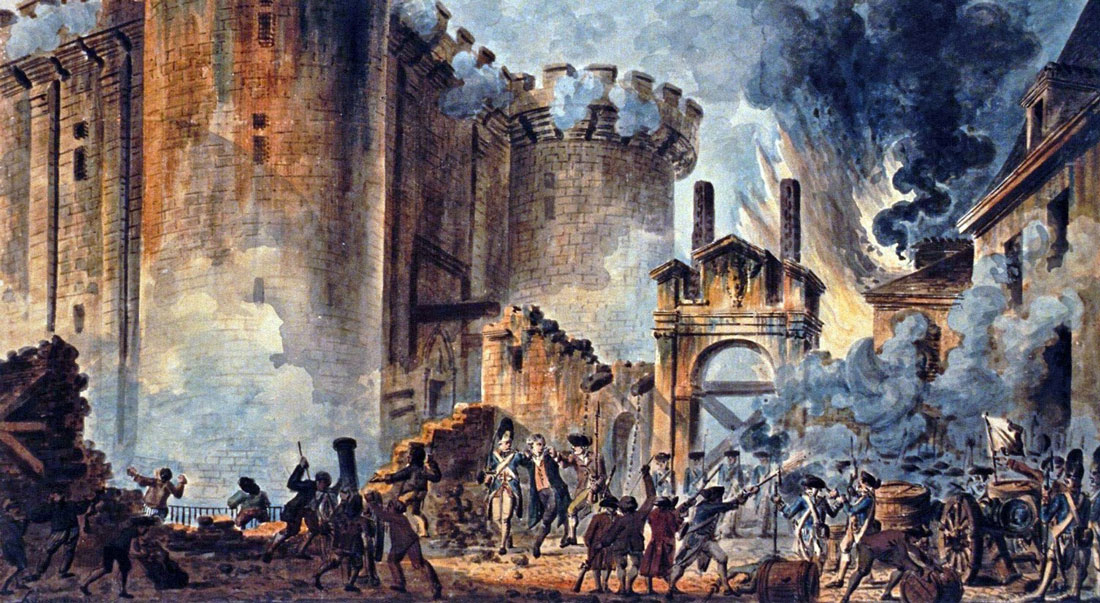
This is the fourth part in a series on how to read Alexis de Tocqueville’s Democracy in America. Read the Introduction and follow the entire series here.
In the previous installment, we considered feudalism as a class system of mutual responsibilities centered on land. Land was the basis of wealth during the medieval period.
But by the 12th century, land was slowly being replaced by trade as the main generator of wealth in Europe. That basic shift and the subsequent ripple effects would eventually lead to the conflict and chaos of the French Revolution. Tocqueville’s proximity to the Revolution in space and time had an enormous influence on his perspective as he traveled the United States.
The Hanseatic League in northern Europe and the Venetian Empire in southern Europe during the 1300s and 1400s were two of the powerful economic coalitions made up of towns and cities that were seeing increased power because of their status as centers of trade. Cities in the Hanseatic League, like Lübeck, Bruges, Hamburg, Bremen, Danzig, and Novgorod were changing the economies in France, Germany, the Baltic kingdoms, Scandinavia, and Russia. Venice and Genoa controlled the trade routes in the Mediterranean and Black Seas. This vast movement of trade goods throughout Europe contributed to the rise of the middle class, or the “bourgeoisie,” as it was known in France.
Along with the growth of the middle class, cities and towns were becoming more important politically and economically during the late medieval and early modern period. The feudal economic order, in which the manor served as the center of economic activity, was being slowly but surely replaced by a more modern economic order, with the town, dominated by the middle class, as the political and economic center.
These changes took place over centuries, but feudal assumptions were resilient. The feudal order was held together by mutual responsibilities between the aristocrats and the commoners. The aristocrats stood as mediating agents between the monarchy and the commoners. They were supposed to provide military and financial aid to the kingdom from the resources drawn from their manors, but they were also to provide justice and stability to the commoners who worked on their manors.
This system of mutual responsibilities broke down in France by the middle of the 1700s. Members of the aristocracy were given the privilege of exemption from paying taxes based on landed wealth (the taille), beginning as far back as the 1400s. Members of the bourgeoisie — the French upper middle class — were allowed to purchase noble titles from the French kings during the 1600s and 1700s, which also gave them exemptions from taxes. Both the nobles and the bourgeoisie moved out of the countryside and away from the commoners into cities and towns — especially to Paris, in order to have more ready access to the king.
In a word, the wealthy classes were becoming more and more isolated from the common people of France. This isolation meant also that the nobles were unable and unwilling to consider the interests of the people who lived on their lands. While life for the commoners was much harder and more dangerous during the height of feudalism in, say, the 1200s, it was more oppressive during the 1700s because the aristocracy had largely abandoned them.
This state of affairs reached the breaking point in 1789 with the storming of the Bastille on July 14 of that month. Events rapidly progressed to the downfall of the French monarchy with the execution of Louis XVI on January 21, 1793.
The immediate cause of the Revolution was a financial crisis. The French monarchy was bankrupt by 1789. Tax relief was necessary, but nobles and high clergy were unwilling to give up their exemptions from paying taxes. Louis was forced to call the Estates General — the representative assembly of France first established during the horrific Hundred Years War in the late 1300s.
Louis’ calling of the Estates General was the first time the body had met in 175 years. During that time, an absolute monarch had ruled France. When the Estates General met, it was comprised of three separate bodies—the First, Second, and Third Estates. The First Estate was made up of the aristocratic clergy, the Second Estate represented the nobles, and the Third Estate comprised the middle class and everyone else. One of the biggest differences between these groups was that members of the First and Second Estates could stand individually to represent their own personal interests. Members of the Third Estate had to speak as a group, represented by one leader. That meant that the members of the First and Second Estates could speak directly to the king on their own individual behalf. The Third Estate had no such access to the king.
This inequality proved unacceptable. Ultimately, the Third Estate met separately at a tennis court in Paris and proclaimed itself the National Assembly, and refused to adjourn until it had drafted a new constitution for France. The creation of the National Assembly in June, the storming of the Bastille in July, and the breakdown of royal authority in the countryside during the autumn of 1789 all resulted in the dissolution of the French monarchy’s power.
The French Revolution is a long and complex story, and my relation of key contributors and events of the Revolution represents just a starting point. But it is an enormously important benchmark from which Tocqueville’s perspective on the United States begins.
Not only was the Revolution a recent event for Tocqueville—he was born in 1805, just 16 years out from the fall of the Bastille. His family suffered great personal loss. His maternal grandfather was guillotined for his role in providing legal defense for the king. His mother and father were both imprisoned for several months on the charge of being loyal to the Bourbons. They were released only after Maximilien Robespierre lost his own head on the guillotine in 1794. The experience of imprisonment emotionally shattered Alexis’ mother. She never fully recovered.
The Revolution of 1789 casts a long shadow over Tocqueville’s political thought. When the July Revolution toppled the last Bourbon king in 1830, Tocqueville sought permission to go to America in part to escape its effects at home. He wondered at how Americans could experience a revolution and yet enjoy a secure and thriving political order in its wake. And in 1856, he wrote one of the best treatments of the French Revolution of the 19th century, The Ancien Regime and the French Revolution. Tocqueville’s analysis of the Revolution bears out the dangers of centralized authority to liberty. Liberty, for Tocqueville, depends on the active public spirit displayed by involved citizens in local communities.
In the next installment, we will look at why Tocqueville wanted to visit America. Then we will turn our attention to the first chapter of Democracy in America.

